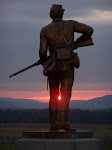
On a few occassions, I've had the opportunity to explore the Pennsylvania Civil War flags collection near the capitol in Harrisburg. Thought I'd take the time to share some stories and photos with you all. The following summary is courtesy of Capitol Preservation Committee. Click any of the photos below to enlarge them.
"Hundreds of heroic stories surround Pennsylvania's Civil War battle flags. More than 300,000 Keystoners answered the call for duty during one of America's most trying times. In the initial days of the war, the Pennsylvania Legislature convened in a special session to provide for the defense of the Commonwealth. Among the new acts passed was one authorizing Governor Andrew G. Curtin to procure battle flags for each regiment that Pennsylvania contributed to the Union Army. Most regiments carried several flags issued either by the state or federal government.
After the war, Pennsylvania's military department was responsible for collecting the state-issued flags. Many of the colors were collected as the regiments mustered out of service. On July 4, 1866, the battle flags were officially returned to the custody of the Commonwealth. On that memorable day, Pennsylvania Civil War veterans, representing the state's 215 regiments, took part in a spectacular parade through the center of Philadelphia, culminating in an impressive ceremony at Independence Hall.
The following day the flags were moved to Harrisburg, where the colors were stored in special cases in the State Arsenal building. In 1872, the Legislature appropriated money to furnish a flag room on the second floor of the Hills Capitol. The flag room was completed in 1873 where these treasured relics remained until 1894. At that time they were removed to the newly erected Executive Library and Museum building (now known as the Speaker Matthew J. Ryan Building).
Twenty years later, June 14, 1914, after architect Joseph M. Huston had finished the new Capitol building, Pennsylvania veterans came together once again to transfer their flags back to the Capitol building.
In a heartrending ceremony, the aged warriors placed the colors in custom-made flag cases in the main rotunda. The flags were kept virtually untouched until 1982 when the Capitol Preservation Committee initiated its "Save the Flags" project. Throughout the years dust had accumulated on the rolled flags, and the long-term vertical display of the flags had placed severe stress on the brittle silk fabric and painted designs. Textile conservators carefully removed the flags from the rotunda and transported them to a state facility near the Capitol.
Over a period of five years, 390 Civil War and twenty-two Spanish-American flags were conserved. Each flag is now kept on an acid-free panel stored in custom designed, stainless steel storage units. The flags are protected from light, dust, fluctuating temperature, humidity, and excessive handling."
 This particular cavalry guidon belonged to the 7th PA Cavalry, in which one of my Civil War ancestors served. Sgt. Sylvester Weakland (related through my father' side) was a blacksmith in the regiment and shoed the horses of the regiment.
This particular cavalry guidon belonged to the 7th PA Cavalry, in which one of my Civil War ancestors served. Sgt. Sylvester Weakland (related through my father' side) was a blacksmith in the regiment and shoed the horses of the regiment. The flags are kept on these acid free shelves and covered in a tissue paper-type material. Each regiment has its own shelf (or shelves) for their respective flags. You can see the other trays covered up in the background.
The flags are kept on these acid free shelves and covered in a tissue paper-type material. Each regiment has its own shelf (or shelves) for their respective flags. You can see the other trays covered up in the background. They also have the the flag staffs in a special drawer cabinet. Here is one that was struck by a bullet in battle. Phew, that was a close one!
They also have the the flag staffs in a special drawer cabinet. Here is one that was struck by a bullet in battle. Phew, that was a close one! Here are some more. More than one has battle damage.
Here are some more. More than one has battle damage.You can see the other pull-out drawers which hold more of the poles.








Very nice Jim. Thanks for sharing!
ReplyDeleteWas a great trip for me and my reenacting unit. Amazing to see these true pieces of Civil War history! We are now able to recreate our OWN flag because of the great conservation efforts put forth by this project! Thanks for the information!
ReplyDelete